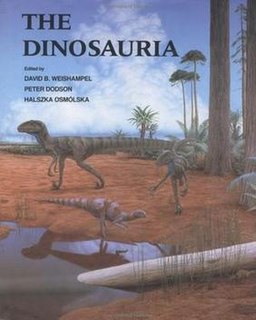The Maleri Formation is a sedimentary rock formation found in Andhra Pradesh, India. It is of Norian age, and is notable for its fossils of early dinosaurs, including the basal saurischian Alwalkeria.
Argiles et Grès à Reptiles Formation is a French geologic formation in the département of Var preserving the remains of several types of dinosaurs and other extinct organisms.
The Twin Mountains Formation, also known as the Twin Mountain Formation, is a sedimentary rock formation, within the Trinity Group, found in Texas of the United States of America. It is a terrestrial formation of Aptian age, and is notable for its dinosaur fossils. Dinosaurs from this formation include the large theropod Acrocanthosaurus, the sauropod Sauroposeidon, as well as the ornithopods Tenontosaurus and Convolosaurus. It is the lowermost unit of the lower Cretaceous, lying unconformably on Carboniferous strata. It is overlain by the Glen Rose Formation. It is the lateral equivalent of the lower part of the Antlers Formation.

The Bushveld Sandstone is a geological formation dating to roughly between 201 and 189 million years ago and covering the Carnian to Norian stages. The Bushveld Sandstone is found in Transvaal, South Africa and is a member of the Stormberg Group. As its name suggests, it consists mainly of sandstone. Fossils of the prosauropod dinosaur Massospondylus have been recovered from the Bushveld Sandstone.
The Moon-Airel Formation is a geological formation in France. It dates back to the early Hettangian.
The Chipping Norton Formation is a geological formation in Europe. It dates back to the Middle Jurassic.
The Alcobaça Formation is a geological formation in Portugal. It dates back to the Oxfordian stage of the Late Jurassic. It is an important source of information on the diversity of Late Jurassic mammals.
The Camadas de Guimarota, simply Guimarota, or Camadas de Alcobaça is a disused coal mine near the city of Leiria in central Portugal. An important geological formation dating back to the Kimmeridgian age of the Late Jurassic period, it contains a diverse array of fossil animals and plants, including dinosaurs and mammals.
The Castellar Formation is a geological formation in La Rioja and Teruel, Spain whose strata date back to the Early Cretaceous. Dinosaur remains are among the fossils that have been recovered from the formation.
The Bauxite of Cornet is a geological formation in Romania whose strata date back to the Early Cretaceous. Dinosaur remains are among the fossils that have been recovered from the formation.
The Sao Khua Formation is a middle member of the Khorat Group. It consists of an alteration of pale red to yellowish-gray, fine to medium-grained sandstone and grayish-reddish brown siltstone and clay. Rare pale red to light gray conglomerates, containing carbonate pebbles, are also characteristic of this Formation. This geological formation in Thailand, dates to the Early Cretaceous age.
The Fort Crittenden Formation is a geological formation in Arizona whose strata date back to the Late Cretaceous. Dinosaur remains are among the fossils that have been recovered from the formation.
The Almond Formation is a geological formation in Wyoming whose strata date back to the Late Cretaceous. Dinosaur remains are among the fossils that have been recovered from the formation.
La Bocana Roja Formation is a geological formation in Baja California, Mexico whose strata date back to the Late Cretaceous. Dinosaur remains are among the fossils that have been recovered from the formation.
The Arén Formation or Arén Sandstone Formation is a geological formation in Arén, Spain whose strata date back to the Late Cretaceous. Dinosaur remains are among the fossils that have been recovered from the formation.
The Beds of Alag Teeg is a geological formation in Mongolia whose strata date back to the Late Cretaceous. Dinosaur remains are among the fossils that have been recovered from the formation.

The Dinosauria is an extensive book on dinosaurs, compiled by David B. Weishampel, Peter Dodson, and Halszka Osmólska. It has been published in 2 editions, with the first edition published in 1990, consisting of material from 23 scientists. The second, greatly revised edition, was published in 2004, with material from 43 scientists. Both editions were published by University of California Press.
The Pictured Cliffs Formation is a Campanian geologic formation in New Mexico. Dinosaur remains are among the fossils that have been recovered from the formation, although none have yet been referred to a specific genus.
The Montemarcello Formation is a Mesozoic geologic formation in Italy. Fossil prosauropod tracks have been reported from the formation.
The Redonda Formation is a Mesozoic geologic formation. Fossil theropod tracks have been reported from the formation.



